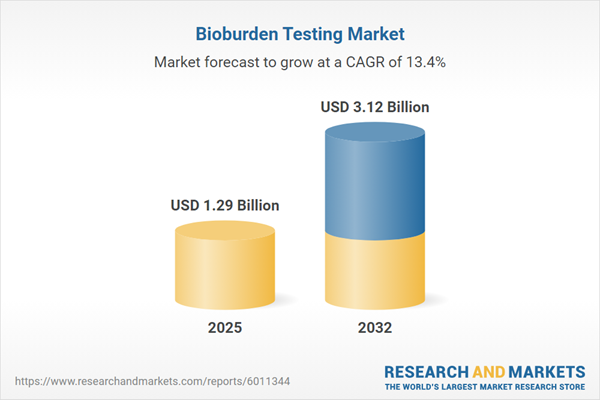Speak directly to the analyst to clarify any post sales queries you may have.
Senior executives navigating today’s compliance-driven markets are turning to advanced bioburden testing strategies to bolster operational resilience and maintain product quality. Across regulated industries, leaders are adopting technology-driven solutions to manage microbial risks, align with evolving regulations, and strengthen organizational responsiveness.
Market Snapshot: Bioburden Testing Market Dynamics and Growth
The bioburden testing market is expanding rapidly, with projections indicating a market size of USD 1.13 billion in 2024 and USD 1.29 billion by 2025, and an anticipated valuation of USD 3.12 billion by 2032. This surge reflects a compound annual growth rate (CAGR) of 13.42%.
Growth is primarily fueled by swift adoption of cutting-edge microbial testing solutions and increasing automation across sectors such as pharmaceuticals, medical devices, and food production. Organizations are strategically investing in next-generation quality management platforms that support both compliance and capacity, integrating digital solutions to ensure operational agility in the face of shifting regulatory expectations and heightened demands for contamination control. Seamless technology integration is helping ensure industry-wide alignment with current and emergent compliance standards.Scope & Segmentation: Bioburden Testing Market Overview
Clear segmentation in the bioburden testing market guides executive decisions related to procurement, laboratory oversight, and risk mitigation. Leveraging these categories enables efficient resource allocation and addresses operational requirements across diverse business models:
- Product Types: Consumables, laboratory instruments, and service offerings each play a pivotal role in streamlining testing workflows and supporting regulatory compliance within controlled environments.
- Technologies: ATP bioluminescence, membrane filtration, and PCR-based methods facilitate precise microbial detection essential for sectors where safety and quality are core priorities.
- Sampling Techniques: Air, contact plate, rinse, and swab sampling methods underpin effective environmental monitoring in manufacturing, clinical, and risk-sensitive settings.
- End Users: Contract research organizations, pharmaceutical manufacturers, food and beverage producers, and medical device companies are reliant on robust testing protocols for risk management and ongoing compliance.
- Geographical Regions: Distinctions in regulatory frameworks and market maturity are noted across the Americas, Europe, Middle East, Africa, and Asia-Pacific, with varying adoption rates for advanced testing and process innovation.
- Company Profiles: Leading market entities including Eurofins Scientific SE, SGS SA, Intertek Group plc, Charles River Laboratories International Inc., Laboratory Corporation of America Holdings, Thermo Fisher Scientific Inc., TÜV SÜD AG, WuXi AppTec Co., Ltd., METTLER-TOLEDO, and Merck KgaA, all address operational and compliance needs across global operations.
Applying segmentation insights enables decision-makers to target supplier partnerships strategically, boost operational efficiency, and direct investments to the most impactful areas of bioburden testing and compliance management.
Key Takeaways for Senior Decision-Makers
- Molecular diagnostic solutions increase the reliability of microbial assessments, reinforcing quality objectives during regulatory shifts.
- Risk-based monitoring approaches provide the flexibility to respond to evolving compliance landscapes and optimize resource deployment.
- Integrating automation and analytics streamlines processes by enhancing traceability, reducing manual errors, and strengthening supply chain responsiveness.
- Alignment with standardized industry protocols—facilitated by collaboration across networks—speeds adaptation to updated regulations and smooths operational transitions.
- Regional regulatory nuances require tailored approaches, making in-depth understanding of compliance environments critical for international operations.
Tariff Impact: Navigating the 2025 U.S. Trade Shifts
Recent U.S. tariff adjustments have redefined the cost framework for imported bioburden testing solutions. Organizations are proactively collaborating with domestic suppliers, establishing long-term procurement agreements, and refining inventory strategies to safeguard continuity of access to essential testing platforms. Open intra-team communication and vendor coordination are proving pivotal for mitigating risks and maintaining consistency throughout supply chain fluctuations related to tariff changes.
Research Methodology & Data Sources
This report draws on direct engagement with laboratory management, quality specialists, and regulatory bodies. Insights are supported by comprehensive literature reviews and validated surveys to deliver trusted, action-oriented intelligence for executive decision-making.
Why This Report Matters
- Equips senior leaders to address complex regulatory requirements and emerging microbiological risks using proven, industry-standard approaches.
- Supports prioritization of laboratory workflow enhancements and compliance initiatives to drive reliable quality management outcomes.
- Prepares organizations to build supplier resilience and adapt operations with confidence as sector and regulatory landscapes evolve.
Conclusion
Implementing innovative, robust bioburden testing strategies empowers organizations to meet intensified compliance standards and overcome emerging quality management challenges. This report offers actionable insights for executives pursuing operational excellence.
Additional Product Information:
- Purchase of this report includes 1 year online access with quarterly updates.
- This report can be updated on request. Please contact our Customer Experience team using the Ask a Question widget on our website.
Table of Contents
3. Executive Summary
4. Market Overview
7. Cumulative Impact of Artificial Intelligence 2025
List of Figures
Companies Mentioned
The companies profiled in this Bioburden Testing market report include:- Eurofins Scientific SE
- SGS SA
- Intertek Group PLC
- Charles River Laboratories International, Inc.
- Laboratory Corporation of America Holdings
- Thermo Fisher Scientific Inc.
- TÜV SÜD AG
- WuXi AppTec Co., Ltd.
- METTLER-TOLEDO
- Merck KgaA
Table Information
| Report Attribute | Details |
|---|---|
| No. of Pages | 198 |
| Published | November 2025 |
| Forecast Period | 2025 - 2032 |
| Estimated Market Value ( USD | $ 1.29 Billion |
| Forecasted Market Value ( USD | $ 3.12 Billion |
| Compound Annual Growth Rate | 13.4% |
| Regions Covered | Global |
| No. of Companies Mentioned | 11 |









